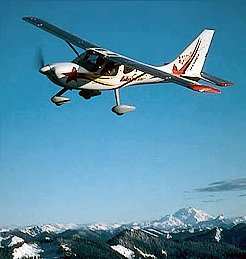Mysteries Persist Despite Video Footage
The NTSB has made public its preliminary report on an 11 April 2023 accident in which an experimental amateur-built Glastar G1 airplane (FILE photo below), registration N8488, was substantially damaged and its two occupants—the pilot and his wife—were fatally injured.

The aircraft’s final flight was conducted under Part 91 and undertaken for purpose of conveying the pilot and his spouse from their winter residence in Nevada to their primary residence in Iowa.
The first day of the planned two-day cross-country flight was to have seen the couple travel as far as Dalhart, Texas, where they intended to overnight and refuel.
On the morning of the accident, a friend of the pilot’s utilized his cellular telephone to film the Glastar’s departure from Cal-Nev-Ari, Nevada’s Kidwell Airport (1L4). Subject individual was also in radio contact with the departing Glastar over the 1L4 Common Traffic Advisory Frequency (CTAF). A review of the video revealed the accident aircraft departed runway 33 at approximately 04:06 PDT. Following an uneventful takeoff-roll and rotation, the Glastar commenced a climbing westerly turn.
As its position lights remained visible in the video, the accident aircraft could be observed entering a right (easterly) turn and continuing in a level flight attitude until it disappeared from frame.
Shortly after establishing the Glastar on an easterly course, the aircraft’s pilot made a farewell call to his friend.
A security camera located at a private residence situated at the south side of the 1L4 airport captured grainy, low-light footage of the departing Glastar. At 04:19 PDT, approximately 11-minutes after the Glastar had departed 1L4, the aircraft was filmed returning to the airport’s vicinity—albeit at a higher altitude—by the selfsame residential security camera.
Subsequent video footage captured the accident aircraft turning in a direction rendered indeterminate by low light and poor resolution. At 04:19:17 PDT, the Glastar entered a rapid descent, impacting the ground 11-seconds later, at 04:19:28 PDT.
The downed aircraft’s wreckage was located in desert terrain some 3,940-feet north-northwest of the departure end of 1L4’s Runway 33 at an elevation of 2,660-feet.
The wreckage was distributed over a 920-foot distance on a median magnetic bearing of 050°.
The first identified points of the Glastar’s contact with the ground consisted of disrupted cacti and dirt on the debris field’s southwestern terminus. Parallel disruptions in the terrain were consistent in size and spacing with the Glastar’s right wheel impacting ground first, followed in short order by its left wheel. The parallel markings continued down the debris field, the space between marked with perpendicular slashes consistent with the aircraft’s propeller repeatedly striking the ground. Fragments of propeller blade were discovered embedded in the soft soil.

A secondary debris field consisted of disrupted dirt and vegetation and a five-inch-wide indentation in the native vegetation and soil from which a blue/green lens—presumably the Glastar’s navigation light—and a large portion of the aircraft’s right wing-tip were recovered. The Glastar’s main wreckage was discovered—upright and facing away from the debris field—in a crater 35-feet beyond the fragmented wing-tip.
The accident aircraft’s last one-hundred-hour inspection was recorded as having been completed on 05 April 2023—six-days prior to the mishap. In addition to stating he wasn’t familiar with the Glastar’s 160-horsepower Eggenfellner Subaru water-cooled, four-cylinder H4 engine, the mechanic by whom the inspection had been signed off stated the pilot performed the entirety of the aircraft’s maintenance and that he (the mechanic) had been retained only to inspect the aircraft for leaks.
A review of the Glastar’s maintenance records revealed that in March 2023, the pilot had installed new fuel injectors and changed the engine’s manifold temperature and oxygen sensors. Though the aircraft’s tachometer was not recovered from the accident site, the Glastar’s maintenance log indicated that at the time of the March 2023 inspection, the aircraft had accumulated a total time of 446.6 hours.
Complete aircraft control continuity could not be established due to the fragmentation of the airframe on impact. No evidence of disconnect or failure was observed, however. The Glastar’s flaps were in the full extended position—as indicated by both the recovered control surfaces and the cockpit Johnson bar.
The accident remains under investigation, ergo the antecedent information is subject to change.
 Unfortunate... ANN/SportPlane Resource Guide Adds To Cautionary Advisories
Unfortunate... ANN/SportPlane Resource Guide Adds To Cautionary Advisories ANN FAQ: Turn On Post Notifications
ANN FAQ: Turn On Post Notifications ANN's Daily Aero-Term (04.29.24): Visual Approach Slope Indicator (VASI)
ANN's Daily Aero-Term (04.29.24): Visual Approach Slope Indicator (VASI) ANN's Daily Aero-Term (04.28.24): Airport Marking Aids
ANN's Daily Aero-Term (04.28.24): Airport Marking Aids ANN's Daily Aero-Linx (04.28.24)
ANN's Daily Aero-Linx (04.28.24)




